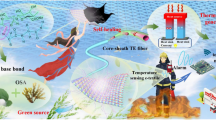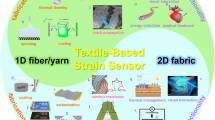Abstract
The effect of the wire diameter and tensile and torsion loads on the remagnetization ability and the stress sensitivity of amorphous Co-alloy wires is investigated. It is shown that amorphous wires have a high magnetic softness to the applied external field in a wide range of diameters of 20–300 μm. The amplitude of the electromagnetic signal of electromotive force (EMF) increases with increasing wire diameter. It is established that amorphous wires with diameter in the range of 50–140 μm are sensitive to applied elastic tensile stresses. Increase in stresses to 300 MPa is accompanied by a fourfold decrease in the amplitude of the EMF signal. These wires are also sensitive to torsion stresses in a weakly and strongly stretched state. The first stage is accompanied by an intense increase in the amplitude of the EMF signal to values near to the amplitude of the original unloaded wire. At the second stage, the amplitude value achieved is preserved. It is established that an optimum interval of recording torsion stresses is determined by the wire diameter and values of applied tensile load. It is concluded that amorphous wires in a wide range of diameters can be used as highly sensitive noncontact sensors of field and tensile and torsion load detectors.





Similar content being viewed by others
REFERENCES
Qin, F. and Peng, H.-X., Ferromagnetic microwires enabled multifunctional composite materials, Progr. Mater. Sci., 2013, vol. 58, pp. 183–259.
Sergueeva, A.V., Walleser, J., Zhou, J., Meacham, B.E., and Branagan, D.J., Ductile high strength microwires from glassy nanosteel alloys, Mater. Sci. Eng., A, 2012, vol. 534, pp. 603–608.
Molokanov, V.V., Chueva, T.R., Umnov, P.P., Shalygina, E.E., and Simakov, S.V., “Thick” amorphous wires in the Fe75Si10B15–Co75Si10B15–Ni75Si10B15 system: fabrication, structure, properties, Inorg. Mater.: Appl. Res., 2016, vol. 7, no. 5, pp. 643–647.
Umnov, P.P., Molokanov, V.V., Shalimov, Yu.S., Umnova, N.V., Chueva, T.R., and Zabolotnyi, V.T., Production of amorphous wire by Ulitovsky–Taylor method using continuous casting, Perspekt. Mater., 2010, no. 2, pp. 87–91.
Molokanov, V.V., Moroz, O.V., Chueva, T.R., Krutilin, A.V., Umnova, N.V., and Umnov, P.P., “Smart” materials based on amorphous wires for biomedicine, Vserossiiskoe soveshchanie “Biomaterialy v meditsine,” Moskva, 18 dekabrya 2017, Tezisy dokladov (All-Russ. Meeting “Biomaterials in Medicine,” Moscow, December 18, 2017, Abstracts of Papers), Moscow: Inst. Metall. Materialoved., Ross. Akad. Nauk, 2017, pp. 45–46.
Molokanov, V.V., Chueva, T.R., Umnova, N.V., and Umnov, P.P., Deformation behavior of a Co69Fe4Cr4Si12B11 amorphous wire for different types of loading, Russ. Metall. (Moscow), 2018, vol. 2018, no. 10, pp. 954–960.
Molokanov, V.V., Chueva, T.R., Umnova, N.V., Umnov, P.P., and Krutilin, A.V., Fracture of the “thick” amorphous Co-alloy wires under bending test, Deform. Razrushenie Mater., 2018, no. 7, pp. 24–29.
Wang, H., Qin, F.X. Xing., D.W., Cao, F.Y., Wang, X.D., Peng, H.X., and Sun, J.F., Relating residual stress and microstructure to mechanical and giant magnetoimpedance properties in cold-drawn Co-based amorphous microwires, Acta Mater., 2012, vol. 60, no. 15, pp. 5425–5436.
Molokanov, V.V., Chueva, T.R., Umnov, P.P., Umnova, N.V., Krutilin, A.V., Shalygina, E.E., Kharlamova, A.M., and Shalygin, A.N., Structure and properties of amorphous finemet alloy microwires produced by the Ulitovskii–Taylor method, Russ. Metall. (Moscow), 2015, vol. 2015, no. 4, pp. 290–294.
Gudoshnikov, S., Ignatov, A., Tarasov, V., Gorbunov, S., Molokanov, V., Chueva, T., and Usov, N., Magnetoelastic properties of Co-based amorphous ferromagnetic microwires, Phys. Status Solidi A, 2016, vol. 213, no. 2, pp. 368–371.
Churyukanova, M., Kaloshkin, S., Shuvaeva, E., Stepashkin, A., Zhdanova, M., Aronin, A., Aksenov, O., Arakelov, P., Zhukova, V., and Zhukov, A., Non-contact method for stress monitoring based on stress dependence of magnetic properties of Fe-based microwires, J. Alloys Compd., 2018, vol. 748, pp. 199–205.
Umnov, P.P., Umnova, N.V., Stegnukhin, A.A., Lavrenyuk, A.V., Samsonova, V.V., and Molokanov, V.V., Effect of quenching conditions on the structure and properties of a “thick” microwire fabricated by the Ulitovskii–Taylor method, Russ. Metall. (Moscow), 2014, vol. 2014, no. 4, pp. 263–266.
Panina, L.V. and Mohri, K., Magneto-impedance effect in amorphous wires, Appl. Phys. Lett., 1994, vol. 65, no. 9, pp. 1189–1196.
Author information
Authors and Affiliations
Corresponding author
Additional information
Translated by A. Muravev
Rights and permissions
About this article
Cite this article
Molokanov, V.V., Chueva, T.R., Umnov, P.P. et al. Stress-Sensory Properties of Amorphous Co-Alloy Wires with Negative Magnetostriction under Elastic Deformation. Inorg. Mater. Appl. Res. 10, 744–748 (2019). https://doi.org/10.1134/S2075113319030286
Received:
Revised:
Accepted:
Published:
Issue Date:
DOI: https://doi.org/10.1134/S2075113319030286




